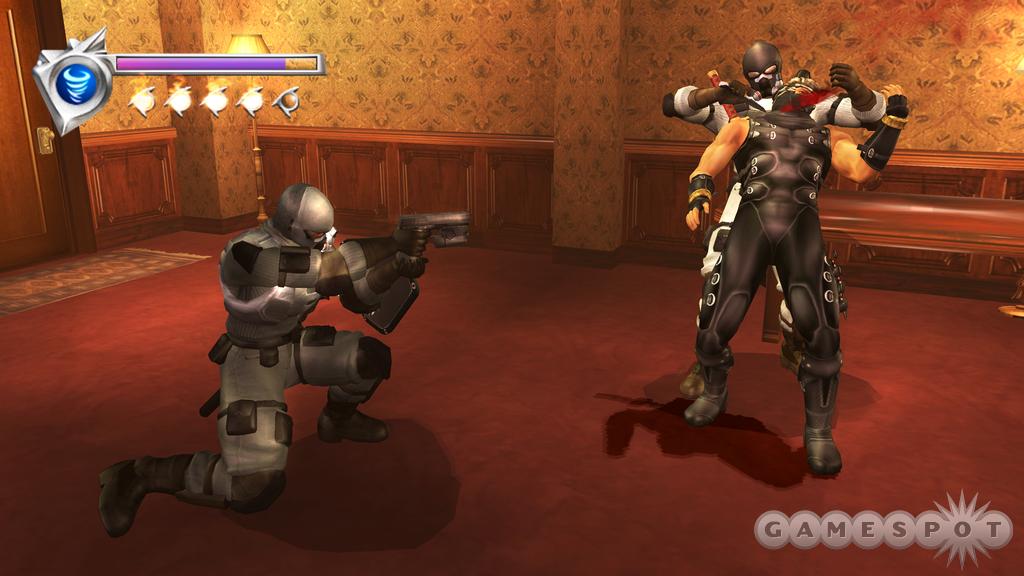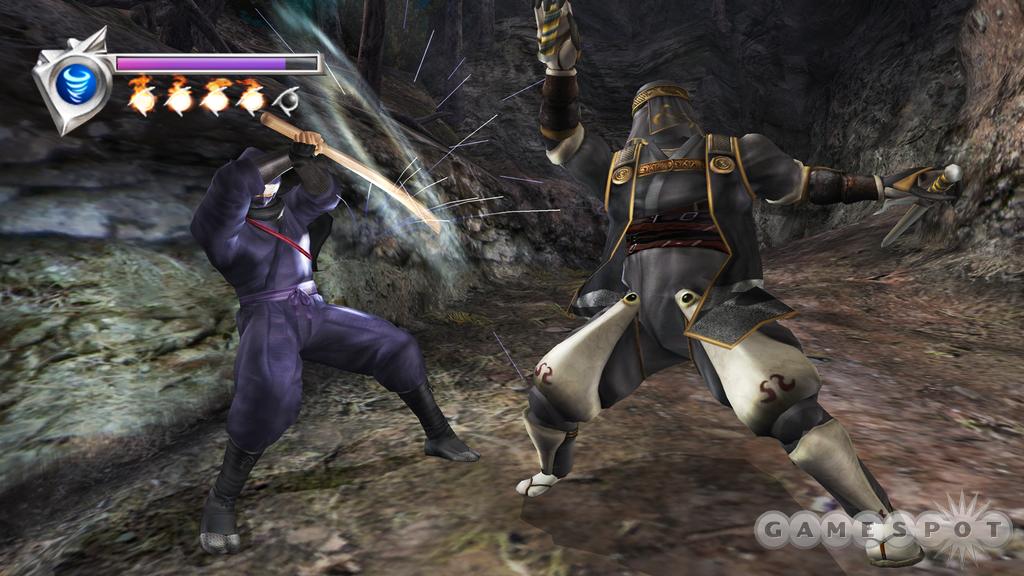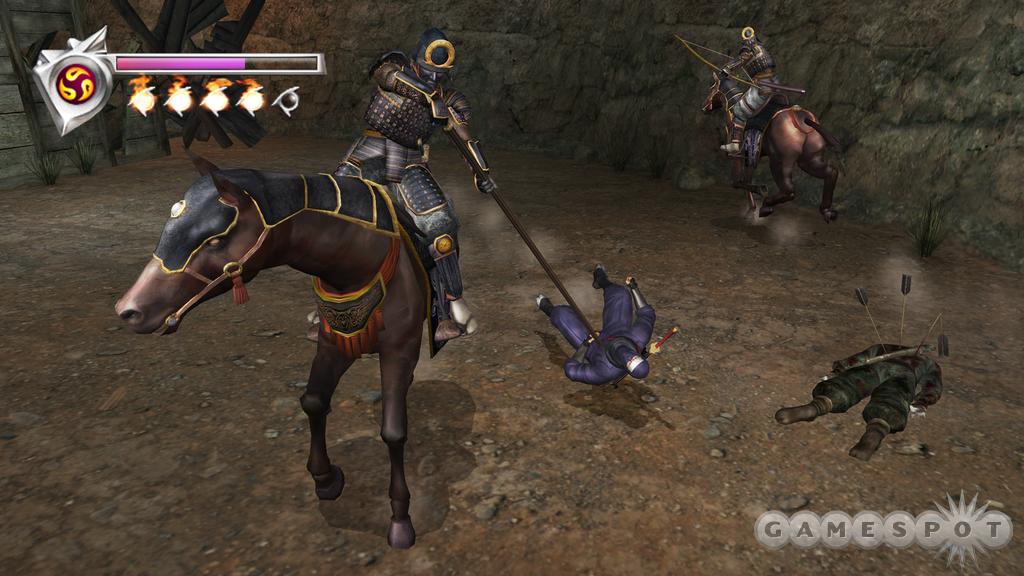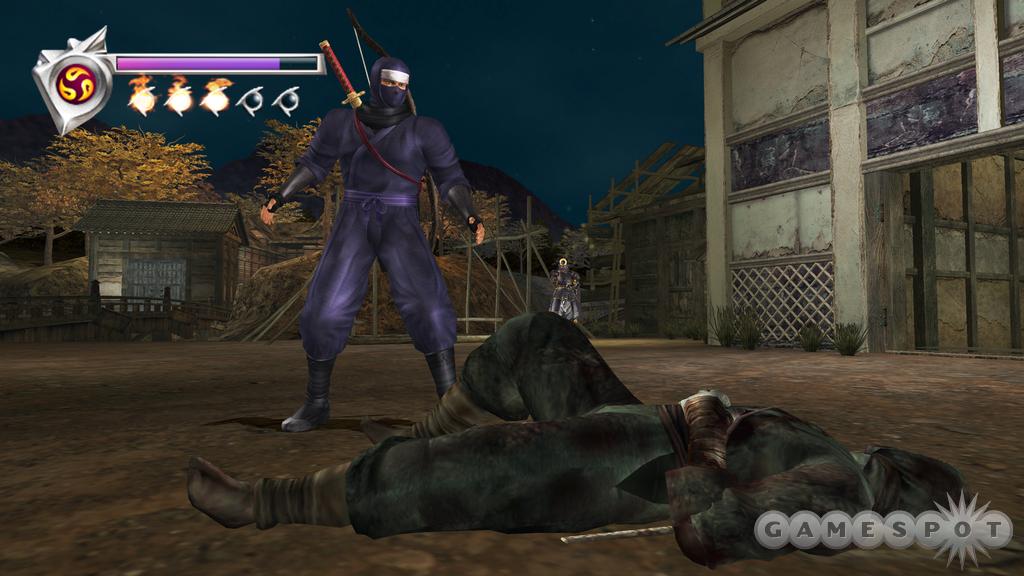Ninja Gaiden originally debuted as a great two-player arcade beat-'em-up back in 1988. But the Nintendo Entertainment System version, which was released about a year later, was completely different--and was even better. It was a very challenging action game in which you'd fight your way through many diverse stages and tough bosses while playing as the vengeful young ninja Ryu Hayabusa. The game spawned a couple of solid sequels, and Ryu Hayabusa has since appeared in Tecmo's Dead or Alive series of fighting games. However, it's been years since a great Ninja Gaiden game has come around. So apparently, Tecmo is making up for lost time, because the new Ninja Gaiden is easily the best in the series. That's no longer a meaningful frame of reference for most people who play games, so let's put it this way: This is one of the best, most challenging action adventure games ever made. Not only does Ninja Gaiden feature bleeding-edge graphics and sound, it boasts simply the best pure action ever seen in such a game.

The premise of the game is similar to the original NES classic, though the storyline is completely self-contained, so no previous experience is expected from you. When Ryu Hayabusa's village is attacked and the evil Dark Dragon Blade is stolen from its centuries-old resting place, the young master ninja brandishes his family's legendary Dragon Sword and sets off on the trail of the villains responsible. While the story gradually unfolds through some spectacular cutscenes, it never really takes center stage, so you'll spend most of the game just wondering who these mysterious villains really are.
Anyway, a revenge plot is the perfect setup for a game about an expert assassin, and a game of this quality doesn't need a complex story to keep you entertained. Suffice it to say that early on Ryu will stow away aboard an airship headed for the Vigoor Empire, which is a mysterious nation supposedly nestled somewhere in western Asia. It's from here that you'll spend most of the game fighting deeper and deeper into the heart of the Empire. And while the Vigoorian streets may look reminiscent of a quaint European town, rest assured that all sorts of danger is lurking everywhere, and plenty of highly imaginative and visually stunning scenery awaits you. You'll end up facing everything from enemy ninjas to military commandos to the living dead to forces of the occult--each in its own native territory, and beyond.
In short, just about everything about this game is superb or better. If there are any rough edges, they are only slightly noticeable, in light of the game's extraordinary quality overall. The entire game looks beautiful and runs at a perfectly smooth frame rate, despite the amount of dynamic action and detail that's onscreen at any given moment. The controls are highly intuitive; they're as responsive as possible; and they result in gameplay that has a surprising amount of depth. The enemies you'll face throughout Ryu's adventure are quite diverse, great-looking, surprisingly smart, and mostly very dangerous. Yet Ryu himself has such an impressive variety of effective moves that defeating them all, as intimidating as it may seem, never is impossible nor does it seem implausible. The look and feel of the action is outstanding. Ryu's slashes seem to pack a tremendous wallop and leave enemies bloodied or even decapitated, which are effects that are far more stylish than gratuitous. Enemy attacks appear incredibly punishing, and indeed, they'll often bring Ryu to death's door.
Ninja Gaiden is difficult. Make no mistake about it. There are no weak enemies to be found, and you'll usually face several of them at once, or else you'll face one very tough (usually very large) boss opponent of some sort. Pattern recognition alone won't get you through this game, since most enemies don't follow obvious patterns in the first place, which means you'll need good reflexes and clever tactics besides. None of the fighting is unfair. It's just that this game requires and rewards skillful play. It truly feels like it was made in the spirit of its predecessors--classic action games that, above all, were meant to provide a fun challenge.

This is not a pure action game, though. In fact, you may be quite surprised to discover that Ninja Gaiden is a full-fledged action adventure game in which you don't just keep fighting, but you gradually acquire new moves and abilities, constantly find valuable items (many of them cleverly hidden), occasionally shop for useful goods, and slowly gain access to larger and larger portions of the gameworld. While the game is structured as a series of more than 15 chapters, most of the game is completely seamless--you'll encounter only a few very brief loading times between chapters and between large portions of the world--so the further in you get, the more territory you're free to explore. However, the game maintains its focus and keeps you on track. You're never forced to spend much time backtracking across the same old territory. Though you'll occasionally find yourself revisiting some of the game's locations as you fight your way through the twisted city of your enemies, things will be different by the time you retrace your footsteps. For example, at one point, Vigoor's entire military force is deployed to take Ryu down the next time he's forced to make his way through the city.
Judged purely as an adventure game (in which exploration and puzzle solving take precedence over combat), Ninja Gaiden works very well. Another surprise is that it has a lot in common with the recent, superbly made Prince of Persia: The Sands of Time, both in concept and in execution. Ryu is an acrobat who's capable of reaching places the average human couldn't. He is so agile that he can run straight up vertical surfaces and can run horizontally along them for a short while. Both techniques are intuitively and automatically performed just by jumping toward a wall from an appropriate angle. While running along a wall, he may even leap toward another wall that's perpendicular to him, thus gaining altitude and momentum to continue his sprint. Using this cool-looking and important technique, he's able to climb up and out of pits as though there were a spiral staircase there to let him walk right on out of it.
Ryu can also triangle-jump off of walls and will often use this technique to bounce his way up through chimney-style openings. He can grab horizontal bars or similar objects and can use them to flip across chasms. He can also swim (while holding his breath for a long time) and fights quite effectively while underwater. Ryu never takes damage from falling, and despite all the acrobatics that take place during the course of Ninja Gaiden, there are very few instances where a missed leap can result in his death. As a result, all the platform jumping shouldn't get frustrating. Additionally, Ryu's adventures will require that he solve a few traditional sorts of action adventure puzzles. For instance, he may have to find certain objects and then place them where they need to go (i.e., hunting for keys), or he may have to pull levers in a particular order, to gain access to new areas. A few timed sequences will also test how precisely you can string together Ryu's various maneuvers to get him through a tricky or dangerous situation within a specific amount of time.

Meanwhile, Ryu will be gathering shiny yellow essence orbs from slain enemies. Consider these orbs gold because he can use them to purchase upgrades for his weapons, or he can purchase useful potions and other things from various storefronts that are found throughout the game (all of which belong to the same shopkeeper). Though the shopping portion of the game isn't very fleshed out, insofar as there aren't too many different kinds of things to buy, it does give you a good incentive to keep taking out enemies and to keep racking up more money, since you'll always want to have enough yellow essence on hand to stock up on spiritual elixirs (also known as healing potions). Ryu will also be able to go out of his way to find numerous hidden items, such as ones that increase his maximum health or ones that increase the maximum number of times he can use his powerful ninja magic. Ryu can also search for golden scarab statuettes that he can then give to the shopkeeper, who rewards Ryu with special goods after every so many scarabs he receives.
However, while navigating strange streets, spelunking in ancient caverns, and buying potions and things is all well and good, Ninja Gaiden's core action and fighting mechanics lie at the heart of its exceptionally good gameplay. In general, you're able to move Ryu with a remarkable fluidity and precision, the likes of which are unmatched by most other games. Tecmo's internal development group, Team Ninja, obviously brought its considerable experience in making fighting games to bear while making Ninja Gaiden, as this game not only features a remarkably extensive variety of combat moves and abilities for its main character, but it lets you perform them intuitively so that the results are incredibly satisfying.
In other words, Ryu Hayabusa is a total badass. Consider just about everything cool you've ever seen a ninja character do in a video game, in an anime, or in a movie. Now, try to understand that Ryu probably has all these moves in his repertoire--and then some.
Granted, he starts off with just a few basic but effective slashing combos--one of which sends his opponent flying into the air so that Ryu can continue his assault while off of the ground. However, Ryu will gradually learn a few new abilities; he'll unlock others by upgrading his weapon; and he'll gain access to plenty more by finding completely different weapons to use. Toward the end of the game, you'll literally have access to more weapons and moves than you'll know what to do with. The good news is that you'll have long since discovered combos and special techniques that you'll find to be extremely effective. And then there's plenty of room left over to practice all the other moves on the game's harder difficulty levels.

Some examples: Ryu's guillotine-throw is a classic throwback to the very first Ninja Gaiden game. It involves leaping toward an enemy as if to land just behind him and then pressing the strong attack button as you're about to make contact, thus causing Ryu--while upside down--to grab the enemy by his neck. Ryu's forward momentum is then transferred, which allows him to fling his poor enemy far forward--ideally smack against a wall or square into some of his cohorts. Better yet, Ryu's izuna drop involves first launching his enemy into midair, then slashing at him a couple of more times for good measure, and finally executing a lethal spinning pile driver... which, as an added bonus, can cause huge amounts of damage to any foe foolish enough to be standing near the point of impact. Ryu also has some excellent countermoves, which can be executed at the precise moment that he blocks an enemy attack. Furthermore, he has tons of great aerial moves. He's even got several devastating charge-up moves, which look (and are) exceptionally powerful, and he can channel the essence orbs of slain enemies for heightened effects. Want more? Ryu's got an unlimited supply of shurikens, plus he can find and use a bow for some first-person-perspective shooting. Additionally, he's got a speargun for dealing with underwater pests. Let's just say that there is no shortage in the variety of action in this game, though admittedly, we found ourselves frequently relying on certain moves, such as the izuna drop, in due time.
The key to the dynamic nature of the action is that Ryu is so mobile. When in doubt, you can always make him leap away from a combat situation, or you can make him leap straight into one. Plus, Ryu's defenses are surprisingly good, so even when he's being mobbed by several enemies, you'll often be able to block all of their attacks just by pressing and holding the left shoulder button. Better yet, you can tumble out of the way by moving the left thumbstick while holding the block button. However, if you spend too much time defending, you'll likely end up on the receiving end of a powerful unblockable attack of some sort, so you really need to stay on your toes. Ultimately, the basic key to survival in Ninja Gaiden is to balance your offense and defense, which sounds simple enough but ends up being a constantly intriguing challenge when squaring off against the game's tough bad guys.
Ninja Gaiden has been in development for more than a couple of years. Early reports about the game suggested that the third-person camera perspective could be difficult to manage. If that was ever the case, there's no evidence of it in the finished product. Camera controls in the game, like most aspects of Ninja Gaiden, are very slick. At any time, you can tap the right shoulder button to reset the perspective behind Ryu's back. However, on its own, the camera generally does a good job of keeping pace with Ryu's fast motions while giving you a useful vantage point of the situation. Furthermore, moving the right analog stick automatically switches to a first-person-perspective view mode, which is used for looking around and becomes particularly useful when a lot of vertical maneuvering is required. It's true that sometimes the camera will move in such a way that you won't see some of the enemies in the vicinity. Even in these cases, though, the game offers a useful option. There's a special kind of jump, performed by pressing two buttons simultaneously, which makes Ryu home in on his nearest enemy. There is no clunky lock-on targeting system in Ninja Gaiden (or any targeting system), because it's unnecessary to have one. Ryu automatically attacks the enemy who's closest to where you happen to be guiding him, and this system works flawlessly.

For what it's worth, there are a few ways in which the game could have been better. In particular, the pacing of some of Ryu's adventures is a little off. Among other things, it's great that this is a lengthy game (expect to spend a good 20 hours your first time through) and that it features a considerable amount of variety. But some sequences, such as a rather difficult level set in the aqueducts beneath the city, seem to drag when compared to others. You'll also fight several of the game's bosses more than once, probably much to the delight of old-school gamers who are accustomed to seeing repeats of tough battles in games. However, this boss battle déjà vu will probably come much to the chagrin of those who are expecting the game to just keep throwing more and more new stuff at them. And, along the same lines, the game's difficulty is a bit haphazard. As mentioned, Ninja Gaiden is generally tough-but-fair. However, certain sequences and boss battles are substantially harder than others--seemingly at random rather than at a gradual pace. For instance, some of the later bosses are complete pushovers compared to some of the earlier ones, and in fact, the early goings-on in Ninja Gaiden are generally tougher than a lot of the latter goings-on.
Also as mentioned, the fact that you're able to wield a variety of different weapons is actually a little strange, since there's no clear incentive to do so (despite the fact that the alternative weapons look very cool). Ryu's trusty Dragon Sword is effective in every situation in the game, so why bother using the nunchakus or the warhammer? It might have been nice if there were situations where Ryu was forced to use these other weapons for battle, but no such situations exist in the game.
The other thing about the game that's slightly awkward is the necessity to access an inventory. You'll frequently have to switch over from the game's action to get to a menu screen to quaff spiritual elixirs and such, which is slightly disruptive at first, though it can be done almost instantly (and eventually becomes second nature). Finally, later on in the game you may find yourself at a bit of an impasse once or twice, as you may find that your game is saved near a very tough boss, and you'll have few, if any, elixirs on hand. These situations are never as hopeless as they may seem, since you should be able to backtrack a bit. Then you can repeatedly enter an area in which enemies are always present so that you can keep killing them until you have enough currency to buy what you need. Again, this throws the pacing off slightly, but since Ninja Gaiden's combat is so entertaining, it's hardly annoying.
Ninja Gaiden is an extremely good-looking game. It's easily one of the best looking Xbox games, and by extension, it's one of the best-looking games ever. You could spot a few weaknesses in the visuals if you tried. Maybe a couple of Ryu's animations, such as when he shimmies across a ledge, don't look as good as when he does everything else. Also, the environments generally aren't very interactive, so don't expect to leave destruction in your wake, in addition to death. Enemies only appear in groups of about three or four at a time, and their corpses all vanish in pools of blood rather than pile up. The perfectly smooth frame rate, on extremely rare occasion, drops to just plain smooth. These are nitpicky issues about a gorgeous-looking game, which supports widescreen, progressive-scan displays for the best possible visual fidelity. Ninja Gaiden boasts imaginative scenery and great-looking character design, as well as a few of Team Ninja's signature graphical touches--if you know what we mean.
The game sounds outstanding, too. Options for English or Japanese voice-over are available. The English dialogue may seem a bit corny at times, but it actually fits very well in the context of a comic book-style, over-the-top game. The sounds of combat in Ninja Gaiden are terrific, especially Ryu's ferocious battle cries--which make him sound about as strong as he is--and the anime-style sound of steel cleaving flesh. Sure enough, the game features a fantastic soundtrack too, with unique music for all the different chapters and many of the boss battles. Some of the tracks loop fairly frequently, but the compositions are catchy and universally excellent, thus effectively fitting the overall tone of both the gameplay sequence in particular and the entire game in general. Those with Dolby Digital 5.1-equipped home theater setups will relish the audio experience all the better.

What's more, Ninja Gaiden has some cool extras in it, including unlockable outfits, a higher difficulty mode, Xbox Live support for future high-score tournaments and downloadable content, and even emulated versions of the trilogy of Ninja Gaiden games for the NES. Sadly, these are surprisingly difficult to find. You don't unlock any of them simply by finishing the game, but instead, you must find them in sequential order during the game itself--first by collecting a large number of the golden scarab artifacts. As a result, some Ninja Gaiden players simply won't get to experience these classic games, but they're a great reward for the effort.
Effort may be required to uncover the game's secrets, not to mention reach its conclusion, but chances are that all you need is to give Ninja Gaiden a look (much less a try) to be extremely impressed by it. Obvious care and detail went into every single aspect of this game. More importantly, obvious and tremendous talent went into every aspect of its execution.